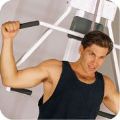|
By now, you're probably no stranger to the notion of step counting and wearable activity trackers. If it seems as though everyone you know is wearing one version or another, that could be the case. In fact, one in five U.S. Walking is good for you and your overall health, whether you start at 5,000 or 15,000 steps. The Centers for Disease Control recommends the average adult try for two hours and 30 minutes of a moderate-intensity aerobic activity every week, every second of which can be easily tracked using your device of choice. What you may not know, though, is the CDC also recommends muscle-strengthening activities on two or more days of the week. If you're hitting your tracker goals, congratulations! Now, it's time to up the ante: Try challenging yourself with some strengthening exercises to round out your aerobic activity. Below, discover three common tracker counts along with recommended exercises you can do at home according to your fitness level. Aim If you 1. Squats to help you focus on your quads and glutes. Try to get in three sets of 10 reps to start. You can do 2. An effective upper-body workout—work on three sets of 10 single-arm dumbbell biceps curls to shape up your arms. 3. Challenge yourself with a cardio and strength workout from Jessica Smith—all you need are weights and an exercise mat. If you 1. Squats on the wall, but instead of doing sets of squats, hold the squat low for one minute. You can do this all at once or split it up into two, 30-second holds. 2. Add on to the aforementioned biceps curl exercises with dumbbell triceps kickbacks, aiming for three sets of 10 reps. 3. Try this 25-minute Pilates-inspired core workout that will strengthen your If you 1. In addition to doing the squats above, add skater squats to your routine to not only work your quads and glutes, but also feel the burn in your hips and outer thighs. 2. Incorporate single-arm dumbbell rows to the biceps curls and triceps kickbacks work listed above. The combination of dynamic moves means you'll work your arms, shoulders and upper back in a short amount of time. 3. This full-body, Once you've committed to fitness, why stop at Strength training is an integral part of health and fitness. It improves your balance and stability, builds muscles, increases your calorie burn and more. Counting steps is a great way to get started, but challenging yourself to step up your tracker game will improve your energy levels, overall health and confidence. |
(002).jpg)






